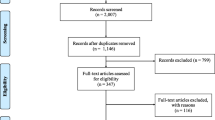Abstract
Aim: Attitudes and practice concerning complementary and alternative medicine (CAM) are currently an area of considerable importance. However, little is known about the overall importance of CAM in groups of health care professionals. Therefore, the primary objective was to analyse the knowledge about and use of CAM in an ethnically diverse student population at the London School of Pharmacy. Methods: A questionnaire was administered to students (264 completed questionnaires, response rate: 59.1%) and in-depth interviews were carried out with a sample of seven students. Results: Forty-three percent reported using at least one type of CAM during the last 12 months. The types of CAM used that were most frequently mentioned include aromatherapy, Traditional Chinese Medicine (TCM) and medicinal herbalism. TCM was reported by students of Chinese origin and by students from other ethnic backgrounds. However, Ayurvedic (Indian) medicine and medicine from Africa were only used in cultures from which the users originated. The study shows that a large number of herbal medical products were commonly reported by students of pharmacy. Conclusion The knowledge about and use of CAM is widespread among this group of future health care professionals and the students also expressed a strong interest in the topic. In-depth studies on the knowledge and use of CAM among other health care professionals and among ethnic minorities are urgently needed and may help to better manage the treatment of minor disorders as well as chronic diseases.
Similar content being viewed by others
References
Zollman C and Vickers A (1999). ABC of complementary medicine. Users and practitioners of complementary medicine. Brit Med J 319: 836–383
Thomas KJ, Fall M, Nicholl J and Williams B (1993). Methodological study to investigate the feasibility of conducting a population-based survey of the use of complementary health care. University of Sheffield, SCHARR
Harris P and Rees R (2000). The prevalence of complementary and alternative medicine use among the general population: a systematic review of the literature. Complement Ther Med 8: 88–96
Thomas KJ, Nicholl JP and Coleman P (2001). Use and expenditure on complementary medicine in England: a population based survey. Complement Ther Med 9: 2–11
Ernst E and White A (2000). The BBC survey of complementary medicine use in the UK. Complement Ther Med 8: 32–36
Barnes J (2003). Pharmacovigilance of herbal medicines. Drug Safety 26: 829–851
Kayne SB (2002) Complementary therapies for pharmacists. Pharmaceutical Press, p. 6–7. ISBN 0-85369-430-3.
Clarke DB, Doel MA and Segrott J (2004). No alternative? The regulation and professionalization of complementary and alternative medicine in the United Kingdom. Health Place 10: 329–338
House of Lords Select Committee on Science and Technology (2000) Session 1999–2000, 6th report. Complementary and alternative medicine. The Stationery Office, London
Leonti M, Sticher O and Heinrich M (2003). Antiquity of medicinal plant usage in two Macro-Mayan Ethnic Groups. J Ethnopharmacol 88: 119–124
Sesselberg T, Wilson KM, Gray NJ and Klein JD (2003). Adolescents’ knowledge of and beliefs about complementary and alternative medicine: a qualitative study. J Adolesc Health 32: 126
Sandhu DS and Heinrich M. (2005). The use of health foods, spices and other botanicals with the Sikh community in London. Phytother Res 19: 633–642
Ernst E (2002). Toxic heavy metals and undeclared drugs in␣Asian herbal medicines. Tr Pharmacol Sci 23: 136–139
Dogra N, Connin S, Gill P, Spencer J and Turner M (2005). Teaching of cultural diversity in medical schools in the United Kingdom and Republic of Ireland: cross sectional questionnaire survey. Brit Med J 330: 403–404
Heinrich, M (2005) Challenges and threats to interdisciplinary medicinal plant research. In: Zahora, Yaniv editor. Handbook of medicinal plants. Haworth Press, Binghampton, New York, USA p. 447–464. ISBN-13: 978-1-56022-994-0
Barnes J (2003). Meeting the impact of the Traditional Herbal Medicinal Products Directive. Complement Ther Med 11: 129–131
Author information
Authors and Affiliations
Corresponding author
Rights and permissions
About this article
Cite this article
Freymann, H., Rennie, T., Bates, I. et al. Knowledge and Use of Complementary and Alternative Medicine among British Undergraduate Pharmacy Students. Pharm World Sci 28, 13–18 (2006). https://doi.org/10.1007/s11096-005-2221-z
Received:
Accepted:
Published:
Issue Date:
DOI: https://doi.org/10.1007/s11096-005-2221-z




